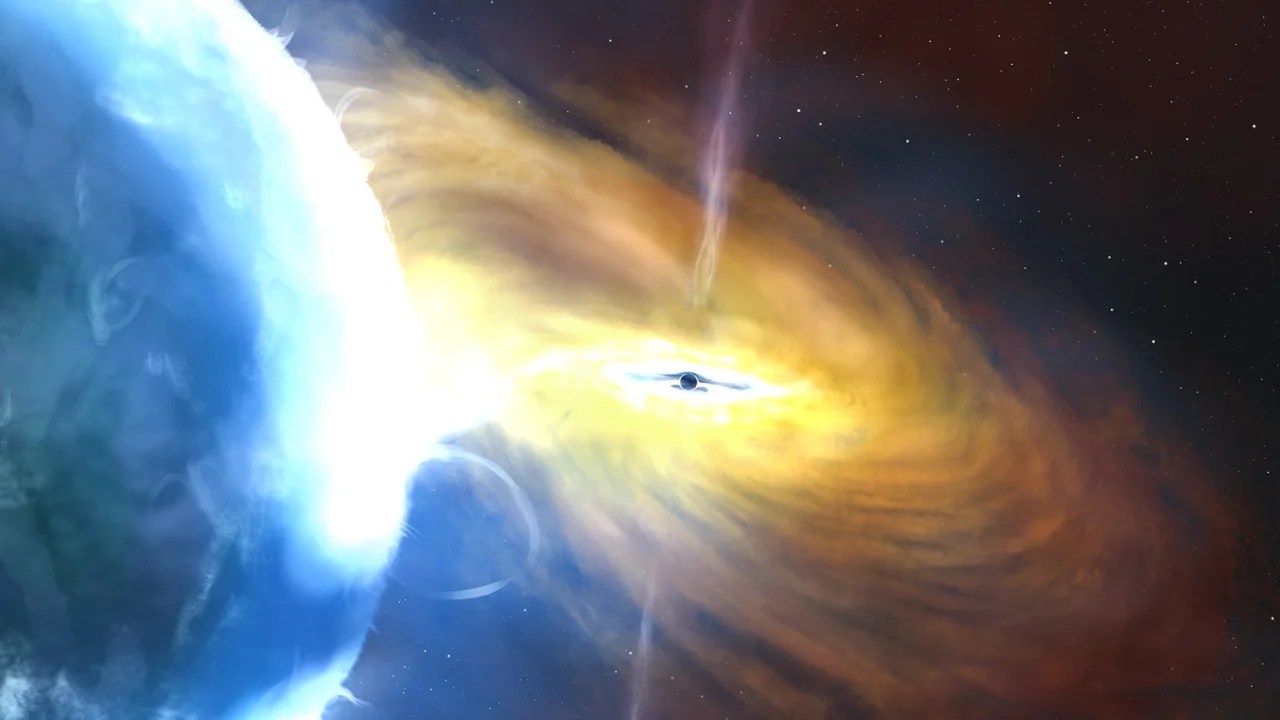(CNN) — Astronomers have discovered the biggest cosmic explosion ever seen, and it’s 10 times brighter than an exploding star or supernova.
The burst’s brightness, called AT2021lwx, lasted three years, while most supernovae only shine for a few months.
The event, still detectable by telescopes, occurred nearly 8 billion light-years from Earth when the universe was about 6 billion years old. The burst’s luminosity is three times higher than other events such as stars collapsing into supermassive black holes.
But what triggered such a large, long-lasting cosmic explosion? Astronomers believe that a supermassive black hole disrupted a giant cloud of gas or dust, thousands of times larger than our Sun. The cloud may have drifted away from its orbit and drifted towards the black hole, the researchers said.
As the black hole swallows pieces of the hydrogen cloud, shock waves reverberate through the remnants of the cloud and into the rotating mass of material surrounding the black hole.
AT2021lwx Event The The gamma-ray burst GRB 221009A 2022 is the brightest cosmic explosion on record. The gamma-ray burst was indeed bright, but it lasted only a fraction of AT2021lwx, which emits more energy overall.
The findings were released Thursday Monthly Notices of the Royal Astronomical Society.
This example shows a black hole absorbing gas, dust, and other cosmic material. Credit: John A. Pies
Astronomers first detected the explosion in November 2020 with the Swicky Transient Facility in California, followed a few months later by the Asteroid Earth Impact Last Warning System in Hawaii. Both are tracking objects in the night sky that change rapidly in brightness, such as exploding stars, asteroids and comets.
“We found this by chance because our search algorithm flagged it while looking for a type of supernova,” lead author of the study Dr. Philip Wiseman, a researcher at the University of Southampton in England, said in a statement. “Most supernova and tidal disruption events last only a few months before fading. One that stays bright for more than a couple of years is immediately very unusual.”
Follow-up observations were made using the space-based Neil Gehrels Swift Observatory, the New Technology Telescope in Chile, and the Gran Telescopio Canarias in La Palma, Spain.
By analyzing the different wavelengths of light used to observe the eruption, the researchers were able to determine the distance between Earth and the event.
“Once you know the distance to the object and how bright it appears to us, you can calculate the brightness of the object at its source,” Sebastian Honig, a professor at the University of Southampton, said in a statement.
The Asteroid Terrestrial Impact Last Alert System has been monitoring the blast every few nights for the past two and a half years.
The research team determined that the incredibly luminous event was nearly 100 times brighter than all 100 billion stars in the Milky Way.
The only celestial objects that rival AT2021lwx’s brightness are quasars, or supermassive black holes that continue to feed on high-velocity gas.
“With a quasar, we see the brightness flicker up and down over time,” study co-author Mark Sullivan, a professor at the University of Southampton, said in a statement. “But looking back more than a decade, AT2021lwx could not be detected, and then suddenly it appears as bright as the brightest things in the universe, which is unprecedented.”
The team had initial theories by studying the luminescence of the explosion. Now researchers want to collect more data using different wavelengths of light to learn more about the phenomenon, including its temperature.
“At first, we thought this flare might be the result of a black hole consuming a passing star. But our models show that the black hole would have to have swallowed 15 times the mass of our Sun to stay bright for so long,” said Dr. Matt Nicol, associate professor at Queen’s University Belfast in Ireland. .in a statement.
“It’s very rare to find such a massive star, so we think a very large gas cloud is likely. Many massive black holes are surrounded by gas and dust, and we’re trying to figure out why this particular black hole started feeding so intensely and suddenly.”




